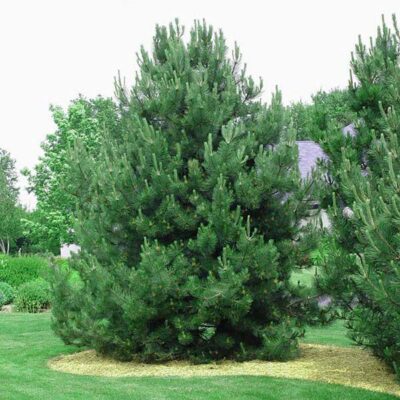Garden Plant: Austrian Pine
Product Description: Austrian Pine

Truly Gorgeous Evergreen Austrian Pine
- Dense Evergreen Screen
- Long Needles Absorb Sound from Roads and Railroads
- Pretty Shape
- Fast Growing
- Widely Adaptable
- Road Salt Tolerant
- Blocks Wind
Used as both an ornamental tree and as part of restoration efforts, Austrian Pine (Pinus nigra) is a wonderfully dense selection that works hard. The strong evergreen branches will screen undesirable views and protect your home from strong winds. It’s year-round good looks are an added bonus!
There are many advantages to selecting this dark green variety, which is also known as European Black Pine. Austrian Pines can add 3 feet or more of new growth in a season! This fast growth rate has helped these Pine trees gain popularity.
With plenty of strong branches holding their long, dark needles all year-long, You’ll always be looking at a beautiful tree, versus that ugly view you hate so much.
These are fantastic evergreens for urban roadways and interchanges. They are salt tolerant and able to withstand dry conditions. The 5-6″ long needles absorb a lot of noise and vibrations and are good plants to include along sound barriers.
The spreading branches of a young tree form a pyramidal outline, but at maturity, it sometimes achieves a picturesque flat-topped head. They bring a tremendous amount of character to a landscape.
We recommend sizing up when possible. When you order the largest trees we have in stock, You’ll get an enormous head start on that privacy you crave. Order today!
How to Use Austrian Pine in the Landscape
Use Austrian Pines for screening, windbreaks or shelterbelts. Their ability to block wind – in combination with road salt tolerance – has put them at the forefront for roadway plantings.
They will block unsightly views or the wind across a residential yard. Don’t forget that those long needles are great at absorbing sound from trains and busy streets!
Follow the old farmer’s trick of planting a staggered – or zig zagged – row of Austrian Pines to block the prevailing winds that blast your property.
For a full screen of mature sized trees, You’ll measure at least 10 feet between the trunk of each tree. You can vary the spacing for a more natural look, however, if you want the tips of the trees to overlap slightly – don’t plant more than 20 feet apart.
Austrian Pines do not need to be planted in straight rows, either. To create a natural look, vary the spacing between trees. Create small groups of trees placed a bit closer together. Plant some closer and some further away. You can really work magic in your landscape with some thoughtful planning.
After all, even a hard-working windbreak can serve dual purposes. Austrian Pines make a nice backdrop for other flowering trees and shrubs to really set them off. Contrast the bold shape with more delicate forms, such as Redbud, Chaste Tree or Weeping Cherry. Birch trees pair beautifully with this tree. And you can imagine how great it would be to add another long row of Lilacs in front of them. Heavenly!
Why not plan to have a gazebo, or hammock stand nestled in the mix? Add an “off-grid” Tipi or Yurt for a fun destination spot on your property. Include a fire pit at least 30 feet away and create a year-round Staycation Paradise.
You can also use Austrian Pine as a single specimen for a restful, Japanese-style Zen garden look. As the plants age, they become more rounded or flat-topped and develop lots of character with interesting bark and interesting form.
Include a large boulder or two and create a magnificent focal point. Add a kinetic sculpture that moves in the wind or install a water feature and You’ve got something wonderful to look at all year long.
Pro Plant Tips for Care
You’ll appreciate how adaptable Austrian Pine is to a variety of environmental conditions. This tree is hardy, and it thrives in urban locations. It will tolerate limestone or acidic soils, dry rocky locations and windy conditions.
They display wonderful adaptability. This durable evergreen tree will thrive in any well drained soil, including clay soils.
Water them regularly as you establish the plants. Once their roots are established in your soil, Austrian Pines grow in areas that are quite dry and will display drought tolerance. However, in times of prolonged drought, it’s a good idea to provide supplemental deep watering to avoid stressing the tree.
Give them plenty of sun, at least 6 hours a day. The more sun, the better the performance.
It’s best to leave Austrian Pine branched right to the ground. Little pruning is required unless you do want to shorten up the new growth when the plants are younger.
To create a dense and uniform outline, try candle pruning in spring.
A biyearly spray of Bonide Copper Fungicide Concentrate can be applied in mid-May and mid-June.
We use PlantSentry to track all federal, state and local regulations for plant materials. We do this to protect communities across the United States.
Order your Austrian Pine today! You’ll love this important partner in your landscape improvement projects. As part of an overall tree diversification strategy, this tree makes a magnificent contribution.


